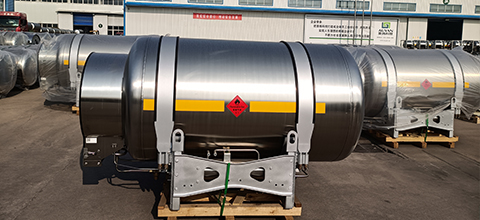Description of LNG vehicle gas cylinder structure design
2022-06-27 11:21:52

The LNG on-board gas cylinder is completely assembled, which can be divided into 7 main parts, including inner container, shell, insulation layer, support device, liquid adding system, pressurization system and vaporization system, realizing four major functions: storage, transportation, liquid and gas supply.
The LNG onboard cylinder consists of an inner tank and a shell.
The inner tank is used to store liquid natural gas. It consists of a straight cylinder welded to an EHA standard oval head to form a closed pressure chamber. The structural material is stainless steel.
The function of the housing is to provide a closed vacuum chamber for vacuum insulation. The housing is made of a straight cylinder welded to THA standard disc head. The construction material is stainless steel. Due to the vacuum, the enclosure withstands external pressure, and the enclosure and its support system can withstand various forces transmitted by the car.
The outer wall of the inner bladder and the inner wall of the shell forms a closed vacuum chamber. LNG onboard cylinders adopt high vacuum multi-layer winding insulation. The vacuum chamber is filled with multilayer insulation material and aluminum foil with a reflective effect, and the insulation material and aluminum foil are alternately wrapped on the outer wall of the inner bladder. The interaction of insulation material and aluminum foil with vacuum forms an efficient insulation system.
Two safety valves are used for over-pressure protection of LNG onboard cylinders. The primary relief valve is opened first and is designed to safely release the pressure increase in the inner vessel due to normal heat leakage through insulation and support systems. The second is the auxiliary relief valve, which has a higher discharge pressure and is designed to provide secondary protection to the internal container in the event of a failure or blockage of the main relief valve. The two-channel protection is designed to ensure the safe use of LNG onboard cylinders.
The shell is equipped with an shell explosion-proof device. In the event of LNG leakage of the liner, the shell will bear internal pressure. The purpose of the shell explosion-proof device is to limit the internal pressure of the shell to a set safe level in case of LNG leakage of the liner. In order to simplify the structure, the shell explosion-proof device and the vacuum plug are combined to design a component, through which the vacuum pumping and vacuum plugging can be realized. As the shell explosion-proof device, when the internal pressure of the shell is exceeded, the plug on the component will open the pressure relief.
The support system is two saddle-shaped bearings, one of which is fixed longitudinally (fixed end), and the mounting hole on the base plate is a round hole. The other is longitudinal sliding (sliding end), the installation hole on the bearing bottom plate is a waist-shaped hole, which is conducive to thermal expansion and cold contraction compensation. The pipe system, instrument and valve are fixed at the fixed end and protected by a protection ring.